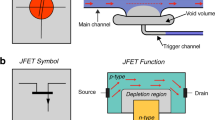Abstract
Using capillary-driven forces as a means to pump and actuate fluids is attractive for many applications including portable, lab-on-a-chip diagnostic systems. However, the lack of reliable and easy-to-integrate means of flow control remains a major challenge for implementing more complex bioassays using capillary microfluidics. This paper presents an easy-to-fabricate, valveless capillary system allowing for high-reliability flow control without using traditional capillary stop or trigger valves. Analytical calculations were used to deduce a design criterion for flow control in the valveless system. Furthermore, electrical analogy modeling was used to analyze and optimize the flow characteristics in the valveless system. Silicon-based test structures and capillary mixing systems were fabricated to check the design criterion and benchmark the electrical analogy model, respectively. Experimental results were in good agreement for the analytically derived flow control criterion. Experimental measurements of the liquid–vapor interface position with respect to time agreed well with the electrical analogy modeling results. The flow control scheme developed in the work provides designers with another means to realize complex fluid processing requirements without the need for traditional valve structures.











Similar content being viewed by others
References
Ajdari A (2004) Steady flows in networks of microfluidic channels: building on the analogy with electrical circuits. C R Phys 5:539
Bruus H (2007) Theoretical microfluidics. Oxford University Press, Oxford, England, U.K
Chakraborty D, Chakraborty S (2010) Microfluidics and Microfabrication. In: Microfluidic transport and micro-scale flow physics: an overview, Springer
Chin C, Linder V, Sia S (2012) Commercialization of microfluidic point-of-care diagnostic devices. Lab Chip 12:2118–2134
Geravis L, Delamarche E (2009) Toward one-step point-of-care immunodiagnostics using capillary-driven microfluidics and PDMS substrates. Lab Chip 9:3330–3337
Junker D, Schmid H, Drechsler U, Wolf H, Wolf M, Michel B, Rooij N, Delamarche E (2002) Autonomous microfluidic capillary system. Anal Chem 74:6139–6144
Kang S, Banerjee D (2011) Modeling and simulation of capillary microfluidic networks based on electrical analogies. J Fluids Eng 133:054502
Laser D, Santiago J (2004) A review of micropumps. J Micromech Microeng 14:R35–R64
Lee J, Moon H, Fowler J, Schoellhammer T, Kim C (2002) Electrowetting and electrowetting-on-dielectric for microscale liquid handling. Sens Actuators A 95:259
Linder V, Sia S, Whitesides G (2005) Reagent-loaded cartridges for valveless and automated fluid delivery in microfluidic devices. Anal Chem 77:64
Majeed B, Jones B, Tezcan D, Tutunjyan N, Haspeslagh L, Peeters S, Fiorini P, Op de Beeck M, Van Hoof C, Hiraoka M, Tanaka H, Yamashita I (2012) Silicon based system for single-nucleotide-polymorphism detection: chip fabrication and thermal characterization of polymerase chain reaction microchamber. Jpn J Appl Phys 51:04DL01
Majeed B, Taher A, Jones B, Sbuncuoglu D (2015) Two step silicon microfluidics for capillary valve applications. Int Symp Microelectron 2015:555–560
Mansouri A, Bhattacharjee S, Kostiuk L (2007) Transient electrokinetic transport in a finite length microchannel: currents, capacitance, and an electrical analogy. J Phys Chem B 111:12834
Melin J, Roxhed N, Gimenez G, Griss P, Van der Wijngaart W, Stemme G (2004) A liquid-triggered liquid microvalve for on-chip flow control. Sens Actuators B 100:463
Oh K, Ahn C (2006) A review of microvalves. J Micromech Microeng 16:13
Oh K, Lee K, Ahn B, Furlani E (2012) Design of pressure-driven microfluidic networks using electric circuit analogy. Lab Chip 12:515
Paik P, Pamula V, Pollack M, Fair R (2003) Electrowetting-based droplet mixers for microfluidic systems. Lab Chip 3:28
Plecis A, Chen Y (2008) Microfluidic analogy of the wheatstone bridge for systematic investigations of electro-osmotic flows. Anal Chem 80:3736
Pollack M, Shenderov A, Fair R (2002) Electrowetting-based actuation of droplets for integrated microfluidics. Lab Chip 2:96
Safavieh R, Juncker D (2013) Capillarics: pre-programmed, self-powered microfluidic circuits built from capillary elements. Lab Chip 13:4180
Safavieh R, Tamayol A, Juncker D (2014) Serpentine and leading-edge capillary pumps for microfluidic capillary systems. Microfluid Nanofluid 18:357
Su W, Gao X, Jiang L, Qin J (2015) Microfluidic platform towards point-of-care diagnostics in infectious diseases. J Chromatogr A 1377:13–26
White F (2006) Viscous Fluid Flow. McGraw-Hill, New York, USA
Zimmermann M, Hunziker P, Delamarche E (2008) Valves for autonomous capillary systems. Microfluid Nanofluid 5:395
Acknowledgements
The authors would like to acknowledge the valuable help of Edith Grac (Imec, Belgium) for providing the MATLAB® code for tracking the liquid–vapor interface inside the microchannel.
Author information
Authors and Affiliations
Corresponding author
Rights and permissions
About this article
Cite this article
Taher, A., Jones, B., Fiorini, P. et al. A valveless capillary mixing system using a novel approach for passive flow control. Microfluid Nanofluid 21, 143 (2017). https://doi.org/10.1007/s10404-017-1981-9
Received:
Accepted:
Published:
DOI: https://doi.org/10.1007/s10404-017-1981-9




